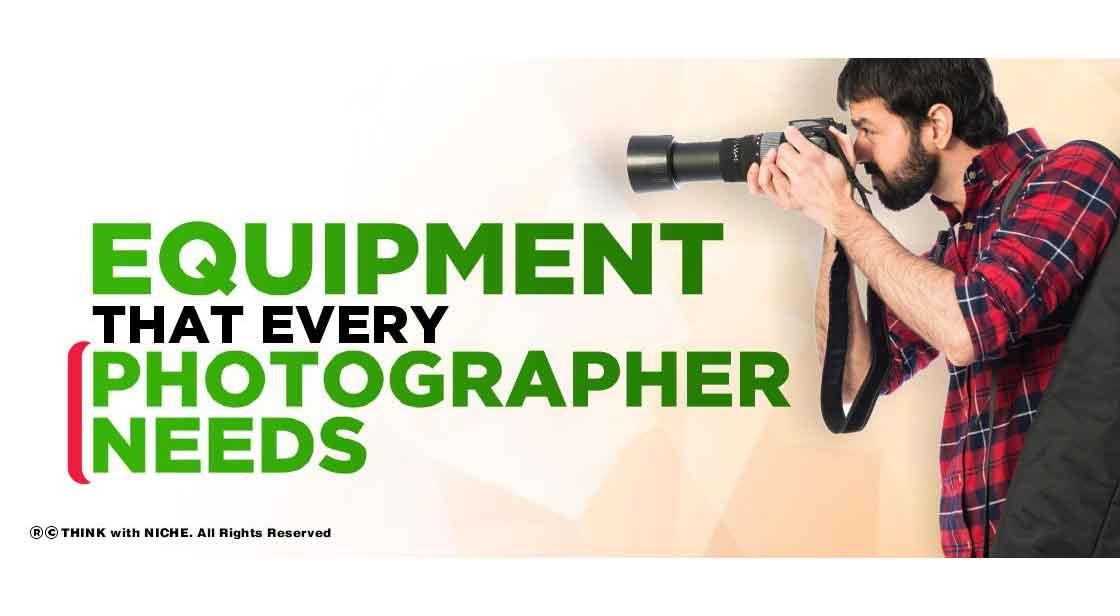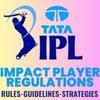Equipment That Every Photographer Needs

Blog Post
Remember, a device doesn’t make you great, but it helps in your journey towards greatness. In the end, your skills and passion will be the only things that will matter. This article is all about the gadgets you might want to invest in before choosing photography as a career. These gadgets will help you go a long way if used properly. With all that being told, we wish you the best of luck for future endeavors in photography. #ThinkWithNiche
Trained your eyes, learned the rules of composition, started looking at the world artistically and creatively. Now is the time to go technical and let your vision represent you. Your smartphone will help you sharpen your skills, and now you have to upgrade to a camera and some related camera gear. To create a visually stunning photograph, you need to have certain pieces of equipment. In this blog, we will talk about some necessary camera gear you might need to begin your career as a photographer. We will also talk about some cameras you could invest in depending upon your expertise level.
Having a camera will do most of the job, but added accessories will give you more creative flexibility. For instance, an artificial light source positioned strategically can create drama in your image that can be mesmerizing to watch. Let’s talk about some of the accessories that you will need.
Must-Have Accessories for a Beginner Photographer
Most of these things will be needed throughout your career as a photographer. As a beginner, they are equally important.
Camera
It is one of the most important things. Without it, I wonder how will you click a photo. A camera will make you push your creative limits and give you full flexibility to experiment and learn. A good camera is like a part of your body. You will have it with you all the time to click images on the go or as planned. A camera that you choose for yourself should be easy to operate. Best cameras for beginners and experts are explained later in this blog to help you choose the best one for you.
Lens
Lenses are more important than the camera. You can’t keep on upgrading your camera, but you can keep upgrading your lens. The lens is what allows the light to fall on the sensor and form the image. The lenses can be switched on the camera body for desired effect or focal length. These lenses are called ‘interchangeable lenses.’ Before you invest in a camera, make sure it is compatible with different lenses. That will save you money in the long run. Lenses are differentiated based on their focal length. Being a beginner photographer, you should be sure about the image you want to shoot before choosing the lens. If you are shooting landscape, you might want to go for a wide-angle lens with a smaller focal length. If you are into wildlife photography, you will need a telephoto lens. Your niche will decide your lens collection, and your lens will decide your photographs. Most of the photographers stick to the kit lens for a very long time. A kit lens is a lens that comes along with the camera body. It can be a great lens, to begin with, because of its variable focal length. The kit lens can be a great companion lens for an enthusiast. The second lens, which most of the photographers go for, and you should too, is a 50mm F/1.8 lens. It is a prime lens and is super cheap and amazing. The bokeh effect it creates will surely make you step out and click. You cannot alter the focal length in primes like a kit or zoom lens. This lens will allow you to move physically, and you will see a change in your perspective towards your subjects and capture stunning images.
Camera Bag
You got your camera and lenses and are ready to shoot and sharpen your skills, but how will you carry them all at once? Lenses are heavier than they look and fragile as well. You won’t dare to damage your new arsenal by carrying and tossing it around. Camera bags are the ones you go for to safeguard your camera equipment. Different photographers need different types of bags for their cameras. A landscape photographer will choose a hiking backpack for keeping his camera and lenses. He will be into the wild and might have a rough hike to find the perfect spot. Similarly, wedding photographers have a trolly suitcase and a backpack to carry every essential equipment they might need at the venue. Different photographers have different bags, and it is up to you what you want to own. Candid Photographer or street photographers carry small bags to stay unnoticed and attract less attention. Be sure to have a bag that can keep your camera safe.
Memory cards
You have everything ready to shoot your first photo on a camera, but suddenly you notice that something is missing in your camera. What is missing? It is a memory card that stores the captured image. Make sure you have a high-speed memory card that can save you time. High-speed memory cards help you in capturing and transferring images to a computer at a faster speed. A 16GB memory card is a must-have card, but the higher, the better. You can go a 32GB, 64GB, or 128GB memory card. Be sure you have multiple cards so that you never run out of space and worry about transferring the data to a laptop every time you are on the shoot.
Tripod
Just like a camera is the most important thing for a photographer, a tripod holds equal importance as well. It doesn’t matter if you’re are a beginner or an expert in your respective field a tripod will always boost your creativity and expand your artistic zone. One of the most famous tripod companies is Manfrotto. You can get the best tripod from them based on your need. For landscape photographers, a tripod is the extension of their camera. A tripod helps them in capturing long exposure images of a scenic place, making it an even more beautiful image. Before you buy any tripod, make sure to know about the payload it can handle. Nowadays, high carbon fiber tripods are available that can carry heavy payloads. Choose the right one and add an extension to your photography.
Filters
What are filters? Good question! They are the glass pieces that are used to modify the light entering the camera. These filters fit in front of the lens and can change the amount of light that enters the lens and ultimately falls on the camera sensor. There are various types of filters, and each one has different functions. Filters are very important when you want to apply some artistic angle to your frame. You don’t need filters in abundance, but carrying one, two, and a set can be more than enough for you. There are:
- ND (Neutral Density) filters.
- Polarizing filters.
- Clear filters.
- ND Graduated Filters.
Flash
In candid photography, flash is not used at all due to the nature of photography. You cannot go on, setting off flashes on the faces and hoping to get natural emotions. A flash, however, is an essential part of some photography niches. In studios, flash acts as recognition equipment that you have entered a studio. Flashes are commonly used in studios, portrait photography, product photography, and many niches that have still subjects or planned photoshoots. When the frame is dark, you can light it up with the help of a flash. It can give you amazing photographs. Every camera now has inbuilt flash housing that can be used to illuminate the scene. You can also spend a few bucks and buy a separate flash that can be placed anywhere to give you good lighting for your photoshoots.
Batteries, extra batteries
As a photographer, you never know when you might run out. When you buy a camera kit, you get a battery in that kit. That single battery won’t help you if you have long shoots. To avoid the time lost during charging, keep extra batteries with you so that you can carry on with your work smoothly. Make sure you buy the correct battery as per your model and from a genuine seller. A third-party battery will damage your camera, so it’s better to buy a genuine battery from an authorized store. So, whenever you go on treks for wildlife or landscape photography, carry extra batteries so that you never miss a shot while charging a battery.
Best cameras for people with different levels of expertise
Everyone was a beginner at some point, and it is crucial to have the right gadget with you to begin your journey. Now I am going to list you some of the best cameras that you can go for based on your experience level.
Beginner level camera
-
Nikon D5300
Let’s Talk about some specifications.
Type of Camera: - It’s a DSLR
Type of sensor: - It has an APS-C sensor
Megapixels: - 24.2 MP
Mount Type: - Nikon F (DX)
Screen Specs: - 3 inch with 921,000 dots
Burst Speed: - 5fps
Video resolution: - Full HD 1080p
Best suited for: - Beginners
-
Olympus E-M10 Mk IV
Let’s Talk about some specifications.
Type of Camera: - It’s a Mirrorless
Type of sensor: - It has a Micro Four Thirds sensor
Megapixels: - 20.3 MP
Mount Type: - MFT
Screen Specs: - 3inch with 1,037k dots, 180° tilt touchscreen
Viewfinder: - 2,360k dots and EVF
Burst Speed: - 8.7fps
Video resolution: - 4K UHD
Best suited for: - Beginners
-
Canon EOS 200D Mk II/Rebel SL3/250D
Let’s Talk about some specifications.
Type of Camera: - It’s a DSLR
Type of sensor: - It has an APS-C sensor
Megapixels: - 24.1 MP
Mount Type: - EF-S
Screen Specs: - 3 inch with 1,040,000 dots
Burst Speed: - 5fps
Video resolution: -4K UHD
Best suited for: - Beginners
-
Fujifilm X-T200
Let's Talk about some specifications.
Type of Camera: - It’s a Mirrorless
Type of sensor: - It has an APS-C sensor
Megapixels: - 24.2 MP
Mount Type: - Fujifilm X
Screen Specs: - 3 inch with 2,760k dots
Burst Speed: - 8fps
Video resolution: - 4K
Best suited for: - Beginners
-
Sony ZV- E10
Let's Talk about some specifications.
Type of Camera: - It’s a Mirrorless
Type of sensor: - It has an APS-C sensor
Megapixels: - 24.2 MP
Mount Type: - E Mount
Screen Specs: - LCD
Burst Speed: - 11fps
Video resolution: - 4K 30p
Best suited for: - Beginners
-
Lumix G100
Let's Talk about some specifications.
Type of Camera: - It’s a Mirrorless
Type of sensor: - It has a Micro Four Thirds sensor
Megapixels: - 20.3 MP
Mount Type: - MFT
Screen Specs: - 3inch with1,840k dots
Burst Speed: - 10fps
Video resolution: - 4K UHD
Best suited for: - Beginners
- Nikon Z fc
Let's Talk about some specifications.
Type of Camera: - It’s a Mirrorless
Type of sensor: - It has an APS-C CMOS sensor
Megapixels: - 24.2 MP
Screen Specs: - 3 inches with 1.04m dots
Burst Speed: - 11fps
Video resolution: - 4K UHD
Best suited for: - Beginners
- Canon EOS M50 Mk II
Let's Talk about some specifications.
Let's Talk about some specifications.
Type of Camera: - It’s a Mirrorless
Type of sensor: - It has an APS-C sensor
Megapixels: - 24.1 MP
Mount Type: - EF-M
Screen Specs: - 3-inch with1,040k dots
Burst Speed: - 10fps
Video resolution: - 4K UHD
Best suited for: - Beginners
-
Nikon Z 50
Let's Talk about some specifications.
Type of Camera: - It’s a Mirrorless
Type of sensor: - It has an APS-C CMOS sensor
Megapixels: - 20.9 MP
Screen Specs: - 3 inches with 1.04m dots
Burst Speed: - 11fps
Video resolution: - 4K UHD
Best suited for: - Beginners
-
Sony A6000
Let's Talk about some specifications.
Type of Camera: - It’s a Mirrorless
Type of sensor: - It has an APS-C sensor
Megapixels: - 24.3 MP
Mount Type: - E mount
Screen Specs: - 3 inch with 921,000 dots
Burst Speed: - 11fps
Video resolution: - Full HD 1080p
Best suited for: - Beginners
Mid-level camera
-
Canon 4000D
Type of Camera: - It’s a DSLR
Megapixels: - 18 MP
Screen Specs: - LCD
Burst speed: - 3 fps
Best suited for: - Intermediates
-
Nikon D3300
Type of Camera: - It’s a DSLR
Megapixels: - 24.2 MP
Screen Specs: - LCD
Burst speed: - 5 fps
Best suited for: - Intermediates
-
Canon Rebel T7
Type of Camera: - It’s a DSLR
Megapixels: - 24 MP
Screen Specs: - LCD
Burst speed: - 3 fps
Best suited for: - Intermediates
-
Nikon D5100
Type of Camera: - It’s a DSLR
Megapixels: - 16 MP
Screen Specs: - LCD
Burst speed: - 4 fps
Best suited for: - Intermediates
-
Pentax K-70
Type of Camera: - It’s a DSLR
Megapixels: - 24 MP
Screen Specs: - LCD
Burst speed: - 6 fps
Best suited for: - Intermediates
-
Sony a68
Type of Camera: - It’s a Mirrorless
Megapixels: - 24 MP
Screen Specs: - LCD
Burst speed: - 8 fps
Best suited for: - Intermediates
-
Lumix G85
Type of Camera: - It’s a Mirrorless
Megapixels: - 16 MP
Screen Specs: - LCD
Burst speed: - 30 fps
Best suited for: - Intermediates
-
Olympus M10 Mk II
Type of Camera: - It’s a Mirrorless
Megapixels: - 16 MP
Screen Specs: - LCD
Burst speed: - 8.5 fps
Best suited for: - Intermediates
-
Sony A6100
Type of Camera: - It’s a Mirrorless
Megapixels: - 24 MP
Screen Specs: - LCD
Burst speed: - 11 fps
Best suited for: - Intermediates
-
Canon M100
Type of Camera: - It’s a Mirrorless
Megapixels: - 24 MP
Screen Specs: - LCD
Burst speed: - 6 fps
Best suited for: - Intermediates
Professional-level camera
-
Canon R5
Type of Camera: - Mirrorless
Sensor Type: - Full-frame
Megapixels: - 45 MP
Mount Type: - Canon RF
Screen Specs: - 3.15-inch touchscreen with 21,000k dots
Viewfinder Type: - EVF(OLED), 100% coverage
Burst speed: - 12 fps mechanical and 20 fps electronic
Video Resolution: - 8K
Best suited for - Professional
-
Canon R3
Type of Camera: - Mirrorless
Sensor Type: - Full-frame
Megapixels: - 24.1 MP
Mount Type: - Canon RF
Screen Specs: - 3.2-inch touchscreen with 4.15 million dots
Viewfinder Type: - EVF(OLED), 100% coverage, 120Hz
Burst speed: - 7 fps
Video Resolution: - 6K 60p
Best suited for - Professional
-
Canon 5D Mk IV
Type of Camera: -DSLR
Sensor Type: - Full-frame
Megapixels: - 30.4 MP
Mount Type: - Canon EF
Screen Specs: - 3.2-inch touchscreen with 1.62 million dots
Viewfinder Type: - Optical
Burst speed: - 7 fps
Video Resolution: - 4K
Best suited for - Professional
-
Sony A1
Type of Camera: - Mirrorless
Sensor Type: - Full-frame
Megapixels: - 50.1 MP
Mount Type: - E Mount
Screen Specs: - 3-inch touchscreen with 1.44 million dots
Viewfinder Type: - EVF with 9.44 million dots
Burst speed: - 10 fps mechanical and 50 fps electronic
Video Resolution: - 8K
Best suited for - Professional
-
Sony A9 Mk II
Type of Camera: - Mirrorless
Sensor Type: - Full-frame
Megapixels: - 24.2 MP
Mount Type: - E Mount
Screen Specs: - 3-inch touchscreen with 1.44 million dots
Viewfinder Type: - EVF
Burst speed: - 10 fps mechanical and 20 fps electronic
Video Resolution: - 4K
Best suited for - Professional
-
Sony A7R Mk IV
Type of Camera: - Mirrorless
Sensor Type: - Full-frame
Megapixels: - 61 MP
Mount Type: - Canon RF
Screen Specs: - 3-inch touchscreen with 1.44 million dots
Viewfinder Type: - EVF with 5.76m dots
Burst speed: - 10 fps
Video Resolution: - 4K
Best suited for - Professional
-
Nikon Z9
Type of Camera: - DSLR
Sensor Type: - Full-frame
Megapixels: - 45.7 MP
Mount Type: - Nikon Z
Screen Specs: - 3-inch touchscreen with 1.04m dots
Burst speed: - 20 fps
Video Resolution: - 8K
Best suited for - Professional
-
Nikon D850
Type of Camera: - DSLR
Sensor Type: - Full-frame
Megapixels: - 45.7 MP
Mount Type: - Nikon F
Screen Specs: - 3.2-inch touchscreen with 2.3m dots
Viewfinder Type: - Optical
Burst speed: - 7 fps
Video Resolution: - 4K
Best suited for - Professional
-
Nikon Z7 Mk II
Type of Camera: - Mirrorless
Sensor Type: - Full-frame CMOS
Megapixels: - 45.7 MP
Mount Type: - Mount Z
Screen Specs: - 3.2-inch touchscreen with 21,000k dots
Viewfinder Type: - EVF, 100% coverage
Burst speed: - 10 fps
Video Resolution: - 4K
Best suited for - Professional
-
Fuji X-T4
Type of Camera: - Mirrorless
Sensor Type: - APS-C
Megapixels: - 26.1 MP
Mount Type: - Fujifilm X
Screen Specs: - 3-inch touchscreen
Viewfinder Type: - EVF with 3.69m dots
Burst speed: - 15 fps mechanical and 30 fps electronic
Video Resolution: - 4K
Best suited for - Professional
-
Fuji GFX 100S
Type of Camera: - Mirrorless
Sensor Type: - Medium Format
Megapixels: - 102 MP
Mount Type: - Fujifilm G
Screen Specs: - 3.2-inch touchscreen with 2.36m dots
Viewfinder Type: - EVF with 5.76m dots
Burst speed: - 5 fps
Video Resolution: - 4K
Best suited for - Professional
-
Lumix SR1
Type of Camera: - Mirrorless
Sensor Type: - Full-frame
Megapixels: - 47.3 MP
Mount Type: - L Mount
Screen Specs: - 3.2-inch touchscreen with 2.1m dots
Viewfinder Type: - EVF
Burst speed: - 9 fps
Video Resolution: - 4K
Best suited for - Professional
-
Lumix GH5
Type of Camera: - Mirrorless
Sensor Type: - Micro four thirds
Megapixels: - 20.3 MP
Mount Type: - MFT Mount
Screen Specs: - 3.2-inch touchscreen with 1.62m dots
Viewfinder Type: - EVF
Burst speed: - 12 fps
Video Resolution: - 4K
Best suited for - Professional
-
Olympus E-M1X
Type of Camera: - Mirrorless
Sensor Type: - Micro Four Thirds
Megapixels: - 20.4 MP
Mount Type: - MFT
Screen Specs: - 3-inch touchscreen
Viewfinder Type: - EVF
Burst speed: - 15 fps
Video Resolution: - 4K
Best suited for - Professional
-
Olympus E-M1 Mk III
Type of Camera: - Mirrorless
Sensor Type: - Micro Four Thirds
Megapixels: - 20.4 MP
Mount Type: - MFT
Screen Specs: - 3-inch touchscreen
Viewfinder Type: - EVF
Burst speed: - 15 fps
Video Resolution: - 4K/4k(cropped)
Best suited for – Professional
Conclusion
With all the cameras listed above, you can go for any of these based on your level. Remember, a device doesn’t make you great, but it helps in your journey towards greatness. In the end, your skills and passion will be the only things that will matter. This article is all about the gadgets you might want to invest in before choosing photography as a career. These gadgets will help you go a long way if used properly. With all that being told, we wish you the best of luck for future endeavors in photography. Till then, keep clicking.
If you enjoyed reading this article, we have two more for you on a similar theme. Click on the link below to explore!
Photography Career Captured Right
You May Like
EDITOR’S CHOICE











